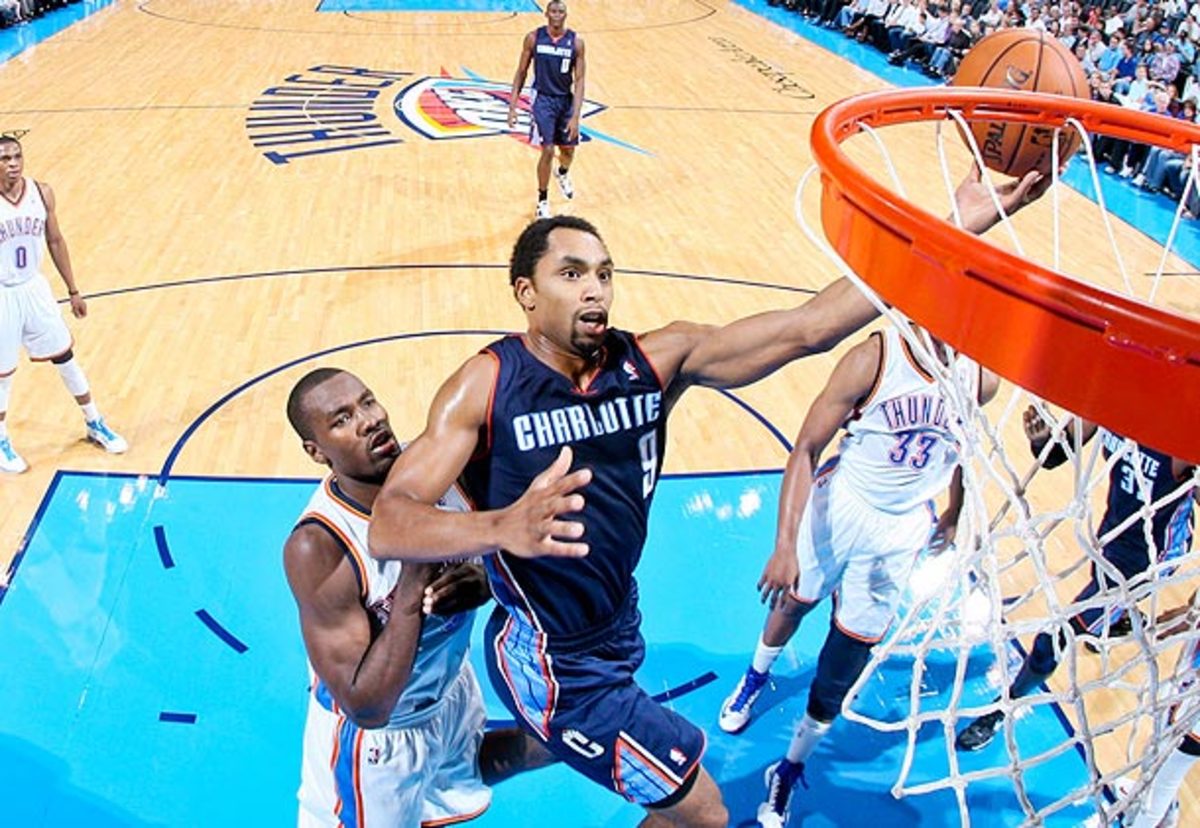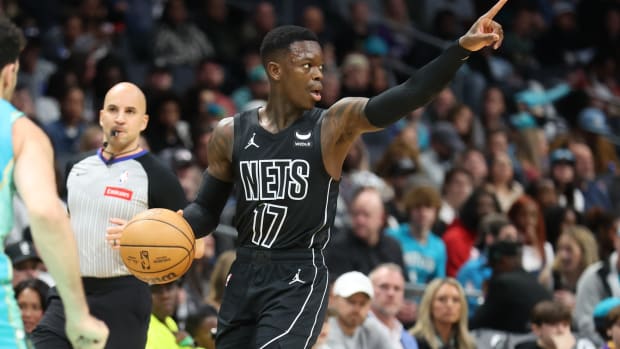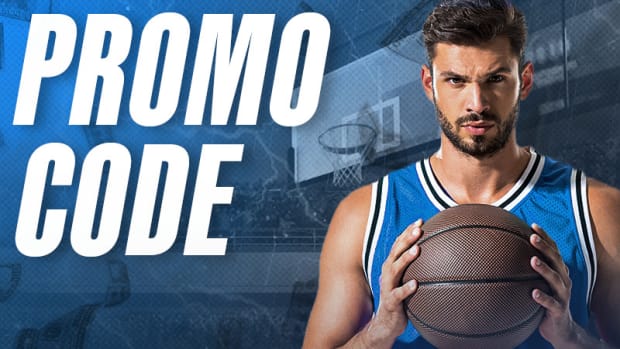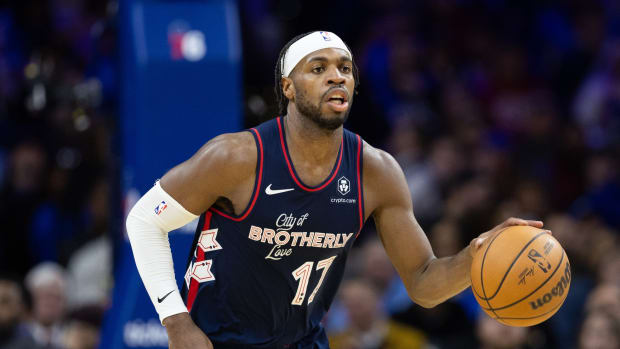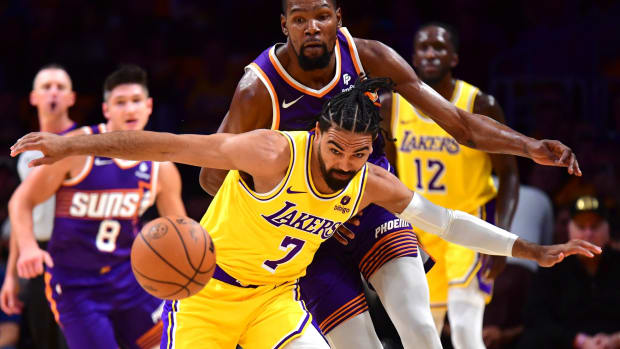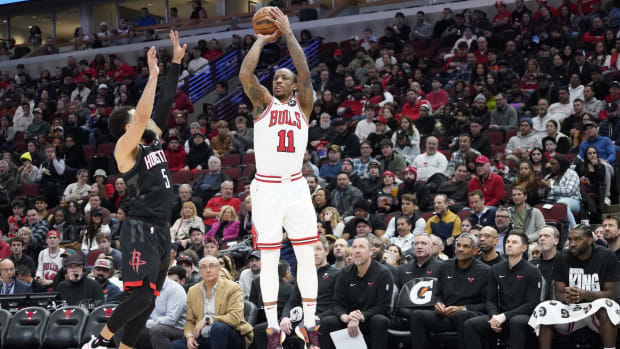Best remaining free agents
Gerald Henderson averaged a career-high 15.5 points last season. (Jeff Siner/Charlotte Observer/MCT via Getty Images)
Most of the top free agents have either officially signed or come to terms on new contracts. But several quality players remain on the market. Here are the best 20 still available, many of whom could be had on cost-effective deals.
1. Nikola Pekovic, C (restricted)
Pekovic’s hulking frame and power game give him a throwback appeal, but a surprising mobility makes him fit to operate in modern offensive and defensive systems. He’s the inside counterpoint that so many perimeter-oriented rosters are missing, or in the case of the incumbent Timberwolves, a cooperative foil for All-Star big man Kevin Love.
When even remotely healthy, Minnesota was an effective defensive team with Pekovic taking up space in the paint and sliding into favorable position. He won’t resemble a standout NBA athlete even on his spriest day, but Pekovic does good work in repelling pick-and-roll action and pushing opponents out of the post.
On offense, Pekovic understands what he does best and rarely strays from the basics. Even without much above-the-rim potential, his strength and footwork allow him the angles and room necessary to finish in traffic, both as a post-up threat and a surprising roll option. He isn’t likely to make any leaps in production at this point (coming off his first NBA contract, Pekovic is already 27), but most every team could find use for a big man with real defensive chops and a bruising interior game.
The Timberwolves are expecting to re-sign Pekovic. They have offered him a four-year deal worth up to $50 million, according to the Minneapolis Star Tribune.
2. Brandon Jennings, G (restricted)
There are certainly things to like about the 23-year-old Jennings -- namely the notion of him as a confident, charismatic source of both scoring and playmaking. He’s put up the raw numbers (17.5 points and 6.5 assists last season) to justify that expectation, but the way in which Jennings reached those marks provides plenty of reason for concern. At the moment, he’s an undiscerning gunner, capable of accomplishing much with the ball in his hands but unable to read situations well enough to understand when he should shoot and when he should pass. To his credit, he did hit 37.5 percent of his 5.8 three-point attempts last season, making his jumper-happy game more palatable than it otherwise could be.
Defensively, Jennings has betrayed every bit of the promise he showed early in his career. He legitimately helped the Bucks guard at a top-five level in his first two seasons. Since then, his coverage has grown increasingly less focused. According to Synergy Sports Technology, Jennings rated miserably in defending both isolation sequences and spot-up opportunities last season -- a basic indicator that he’s become a liability both on and off the ball. Quickness alone just can’t save a defender who takes such an open stance (thus surrendering easy blow-bys) in coverage and gets caught ball-watching on a frequent basis. Teams should be given pause by the fact that three years and change under Scott Skiles has done so little for Jennings’ defensive fundamentals.
With Atlanta now out of the mix as a potential suitor after matching Milwaukee's offer for point guard Jeff Teague, Jennings might be best served signing his one-year qualifying offer (worth $4.5 million) and aiming for unrestricted free agency a year from now. Otherwise, he could wind up signing a long-term deal with the team he's seemed intent to leave behind, all in the name of immediate financial security.
3. Gerald Henderson, G (restricted)
Aside from his gravity-defying throwdown early in the season, Henderson had a quiet year in a starting role for one of the worst teams in basketball. That’s not a great way to build a résumé, but Henderson’s performance has been sturdy enough to wonder what he might be capable of in a different context.
The Bobcats were such a mess that it’s difficult to evaluate Henderson’s defensive value within the team concept. The effort was clearly there, but Charlotte’s defenders were so rarely on the same page that it’s hard to know if Henderson was really executing as intended. Nevertheless, the 25-year-old has shown nice defensive potential over the past few seasons, and according to Synergy Sports, Henderson allowed just 0.66 points per play (and 32.3 percent shooting) in isolation situations last season. He's clearly reliable enough to stay in front of most perimeter threats, and Henderson should do well if empowered by the fundamentals and principles of a more consistent defense.
Offensively, Henderson is skilled overall but doesn’t have a specialty. He has dabbled in pick-and-roll play, does rather well in the post and has improved as a spot-up shooter. He still needs to become a more consistent threat from beyond the arc, but he’s progressively attempted more threes in every season and made a big step toward league-average marksmanship last season by shooting 33 percent.
Henderson, the 12th pick in the 2009 draft, and the Bobcats have yet to agree on a new deal. If the two parties reach an impasse, Henderson could play out a one-year qualifying offer for nearly $4.3 million or the Bobcats could pursue a sign-and-trade.
4. Brandan Wright, F/C
Because of injury, recovery and what often amounted to a minor role with the Mavericks, the 25-year-old six-year veteran has played roughly the same number of NBA minutes as two-year veterans Kenneth Faried and Nikola Vucevic, with the prime of his career still to come. He was drafted in 2007, but all of the above factors make him quite raw by NBA standards, and theoretically interesting to any team in need of an energetic big man to round out its rotation.
Wright is an odd player in that he thrives on an array of runners and floaters, but Dallas had some success focusing his athletic gifts in the pick-and-roll. In the right context (read: with the right playmaker), Wright could be even more effective and potentially prove to be a starting-level contributor as he gets more experience. For now, he’s an effective finisher, a source of instant energy and a bouncy, quick-footed asset on defense. Nothing in his game suggests star potential, but Wright is already the kind of role player who creates value (via rolling to the rim, spacing the floor a bit, etc.) beyond his individual production.
Talk from Mavs team officials -- including owner Mark Cuban -- seems to presume that Wright will be back in Dallas next season, likely using the Early Bird exception.
UPDATE: The Mavs have agreed to a two-year, $5 million deal with Wright, according to NBA.com.
5. Mo Williams, G
Williams can create and initiate offense at a relatively consistent level, but he has looked most viable when playing alongside another dominant ball handler. For example: In their two seasons together in Cleveland, Williams worked well off of LeBron James and converted 45 percent from three-point range -- a nice leap from his career average of 38.6. A perfect fit would also include the potential to be hidden defensively on the perimeter through cross-matching; Williams, 30, isn’t so bad in coverage that he dooms his team's defense by walking on the court, but in many cases he’s in dire need of matchup help to minimize the damage he often surrenders.
6. Beno Udrih, G
Udrih, 31, has often been disregarded as yet another blank, boring point guard, but he’s a decent NBA player with a good shooting touch. The pull-up jumper, in particular, is his darling -- for better or worse, in sickness and in health, for as long as he and his jumper shall live. As a result of that commitment, 63 percent of Udrih’s shot attempts last season came either from mid-range or just inside the paint (but outside the restricted area). That’s fine as long as he continues to convert those shots at such a sound rate (he made 44.6 percent of them while splitting time with Milwaukee and Orlando), but Udrih’s pull-up style tends not to draw the defensive attention necessary to free up teammates or earn free-throw attempts. Essentially, he’s a quality scoring option off the dribble without any of the tangential benefits of driving -- a reality that makes him fairly valuable but pretty clearly limited.
7. Mike Miller, G/F
There's no way around Miller's back issues at this point, but the 33-year-old can nonetheless help a team on a semi-consistent basis with great perimeter shooting, smart passing and all-around effort. The ranks of free-agent marksmen have largely been picked over by this point, making Miller's injury potential (he's played roughly 60 percent of his team's regular-season games over the past four seasons) an easier pill to swallow for the sake of acquiring such an exceptional outside shooter.
His game is also far too broad for him to be deemed a specialist. He's impeccably prepared, as evidenced by his hot shooting for Miami at a moment's notice in the last two postseasons. He's a quick-fire shooter without a get-mine mentality and actively contributes to the ball and player movement so essential to good offense. Miller also happens to be a fantastic out-of-position rebounder who will track loose balls from across the court, and a competent ball handler who can initiate basic offense in a pinch. After Miami waived him in a cost-cutting move, Miller will be a great addition for the Thunder, Grizzlies or any number of playoff teams.
UPDATE:Miller has agreed to sign with Memphis.
8. DeJuan Blair, F/C
Blair, 24, fell out of San Antonio’s rotation last season, in part because of his inability to mesh on the court with Tim Duncan and Tiago Splitter. But his per-minute productivity over the last four years (14.9 points and 11.1 rebounds per 36 minutes) suggests that he’s more than capable of succeeding in a bigger role. He should do well as a rotation regular on another team, despite his defensive lapses, short stature and concern over his ACL-absent knees.
9. Gary Neal, G (restricted)
Gary Neal is a shooter, and there is no force on this planet -- not Gregg Popovich, not the Spurs' on-court leaders, not Neal's own better judgment -- that can stop him from firing away. Neal's shot selection can be so unruly (and his defense so spotty) at times that he can be unplayable, though he can also be so accurate from deep as to bury opponents with a one-man barrage.
Neal, 28, is coming off a down year in terms of perimeter shooting, but he still registered an above-average percentage (35.5) while hoisting 6.1 long-range attempts per 36 minutes. It doesn't hurt that Neal can handle the ball as needed and is getting better about swinging it to open teammates on the perimeter. He's still vulnerable to lapses in judgment, but teams willing to accept that possession-to-possession risk should benefit from Neal's shooting and occasional contributions off the bounce.
Even after signing Marco Belinelli to a multiyear deal, San Antonio could still bring Neal back to help fortify its point guard rotation. Backups Cory Joseph and Nando De Colo are still shaky enough to need insurance, which makes Neal a nice piece to have around.
10. Drew Gooden, F
Gooden's eccentricity, (amnestied) mid-level contract and tendency to put up solid stats on bad teams has rendered him as something of a punchline, but when divorced from that reputation, he's still a perfectly useful NBA big man. His struggles within a team defensive concept (slow help, poor positioning, etc.) are severe enough to make him best suited for a limited role, but the 31-year-old Gooden actually does a surprisingly solid job of guarding opponents one-on-one and can hold his own on the block.
It's tough to say exactly where Gooden is as a player after a season in which he played only 151 minutes for Milwaukee, but in theory he could offer solid two-way rebounding and low-maintenance scoring for a minimal price. His isn't the kind of addition that could really move the needle for a top team, but Gooden is still viable enough to sop up playing time and mitigate the drop-off when a team's best big men catch a breather.
Tyrus Thomas (left) played only 26 games for Charlotte last season. (Scott Cunningham/NBAE via Getty Images(
11. Ivan Johnson, F
With a bruising style, the 6-8, 255-pound Johnson is able to work his way into random scraps around the basket -- largely from loose balls and drop passes -- and hang in there defensively, but a lack of size and pro-level athleticism holds him back. He'll tangle with any post-up threat and does well to get in the way of pick-and-roll action, but the 29-year-old Johnson, who played for Atlanta the last two seasons, doesn't have the length to challenge shots in the paint on a regular basis.
The same problem comes into play on offense. Johnson doesn't have the footwork or interior skills necessary to make up for a lack of physical advantages, leaving him to clean up broken plays, capitalize on offensive rebounds and step out for spot-up mid-range jumpers. The total package is still well worth a slot as an NBA regular, but only with the above caveats in mind.
12. Tyrus Thomas, F
When healthy and willing to play along, Thomas, who hasn't played more than 54 games in a season since 2008-09, fits the mold of the ideal low-usage big man because of his springy interior defense and athletic pick-and-roll capabilities. But Thomas exploits that potential with increasing infrequency, to the point that Charlotte amnestied the former No. 4 pick (and ate the $18.1 million he's owed over the next two seasons) to create cap room. Teams will remain intrigued with Thomas because he's still young (26) and fairly productive (12.5 points, 6.0 rebounds. 1.5 steals and 1.5 blocks per 36 minutes last season).
13. Rodrigue Beaubois, G
Beaubois can officially be labeled a reclamation project. Repeated injury and chronic inconsistency have played a sizable part in the 25-year-old’s decline, but even more damning is Beaubois’ dwindling command of the elements of the game that previously came so easily to him. As an unknown rookie in 2009-10, Beaubois showed an excellent capacity for haphazard offense and provided Dallas with an alternative source of scoring when the usual channels broke down. But 2012-13 marked the third consecutive season in which Beaubois’ per-minute scoring dropped. Over the course of his rookie deal, he’s gone from averaging 20.3 points per 36 minutes to a Tony Allen-like 11.9 -- so steep a drop that he could offer little to a Mavericks team that suffered mightily for perimeter shot creation and steady ball handling.
A season-ending hand injury that Beaubois sustained in March should be healed by the time training camp rolls around. But even when healthy, he’s proved to be too spotty a scorer and too limited a facilitator to warrant any significant investment.
14. Kenyon Martin, F
Martin, a mediocre rebounder and limited offensive player, is valued for his ability to defend the interior. Most every playoff team needs another player capable of rotating reliably and guarding the post -- two attributes that happen to be Martin’s strong suits. The 35-year-old is a known quantity, for better or worse, as his end-of-season run with the Knicks simultaneously showcased what he can offer to a competitive team under the right circumstances and how his lack of offense might hold some teams back.
UPDATE: Martin is returning to the Knicks on a one-year deal.
15. Cole Aldrich, C
Aldrich, 24, hasn't had much luck finding an NBA home -- he's played for three teams since being drafted No. 11 in 2010 -- and a lack of athleticism, range and post moves have prevented him from creating any offensive value. But he's a young, mobile big man who plays intelligent defense. He has enough defensive potential to project as a rotation-caliber player.
16. Timofey Mozgov, C (restricted)
Mozgov, 27, averaged only 8.9 minutes in 41 games last season as part of an odd center rotation in Denver that included Kosta Koufos, JaVale McGee, and Kenneth Faried. Given the alternatives, that was a fair decision. The 7-1 Mozgov is a decent defensive big man, but not so effective to make up for his offensive limitations; he doesn't have a very good feel for defending in space and winds up committing tons of fouls as a result. His size allows him to finish around the basket easily enough, but Mozgov doesn't have much capacity to change directions or angles to respond to defensive play.
17. Lamar Odom, F
Although he barely resembles the ultra-versatile star he once was, Odom remains a decent NBA player because of his long-underrated ability to cover so many different types of opponents and move well within a team defensive concept. His scoring and off-the-dribble game are greatly diminished, and he's no longer a credible option at small forward. But Odom, 33, was still a net positive for the Clippers last season because of his coverage and rebounding.
18. Ronnie Brewer, G/F
Floor spacing isn't merely a product of perimeter accuracy; players such as Brewer who move well without the ball can offer their team some of the same benefit that a more conventional spot-up threat might, albeit in a way that leans more heavily on playmakers to read the entire floor and find the cutter at the perfect time. But that defense of Brewer, 27, means that he needs particular conditions to succeed, even if his work as a perimeter defender remains solid. Teams have little incentive to rely on a player with such limited offensive range and little hope for significant improvement as a shooter.
19. Sebastian Telfair, G
Telfair, 28, had a respectable run for the Suns last season before being traded to the spacing-challenged Raptors. He rates as a worthwhile pick-and-roll player for a bargain price. His view of the court isn't quite as broad as his coaches might like, but Telfair does a nice job of knifing through the defense off of high screens to create makeable mid-range looks. The fact that he doesn't get all the way to the rim on those pick-and-roll drives is part of what hamstrings his shooting efficiency.






























